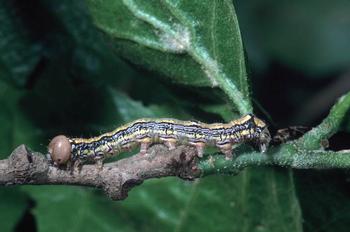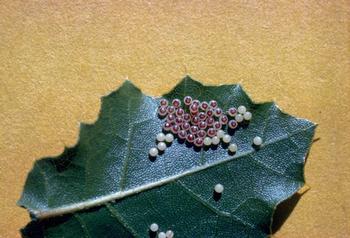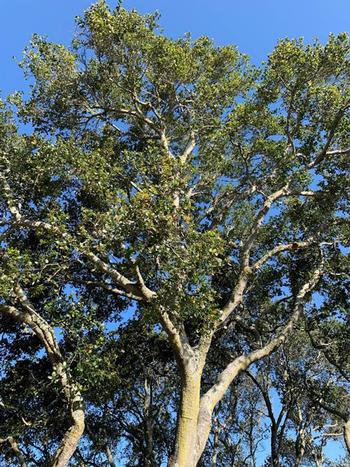The California oakworm: not really a worm, just a very hungry caterpillar
-
Anne-Marie Walker
-
Oaks define the visual beauty of California landscapes and support wildlife and biodiversity. Those of us who live among oaks hold our breath in spring when California oakworms, not really worms but very hungry caterpillars, munch away defoliating oaks. Fortunately, we can collectively take a big breath as this does not usually cause serious harm to healthy trees.
 California oakworm larva grow to about 1 ¼ inch long. Photo: Jack Kelly Clark courtesy the University of California Statewide IPM Program
California oakworm larva grow to about 1 ¼ inch long. Photo: Jack Kelly Clark courtesy the University of California Statewide IPM Program
Early inhabitants of California oak woodlands were sustained by acorns, California oak chanterelles, manzanita, and quail, to name just a few seeds, fungi, plants, and animals associated with oaks. The Coast live oak dominant in Marin’s coastal hills is distinguished by evergreen leathery leaves, narrowly cone-shaped acorns, and gray bark. On the undersides of these oak leaves, the California oak moth lays its eggs in fall. In early spring, pale green young caterpillars that look like worms begin to feed voraciously on oak leaves frequently dropping from trees. The hungry caterpillar grows to over 1 inch turning mostly black with prominent stripes. It spins a colorful chrysalis and emerges as the oak moth that lives only to lay more eggs producing a second generation in summer.For a short period, calls to the UC Marin Master Gardener Help Desk escalate as folks ask how to get rid of this “pest.” Because oaks and California oakworms co-evolved, they are well adapted to caterpillar surges. In times of drought, oaks have adapted to lose some leaves, limiting the loss of water through transpiration. Healthy oaks that lose leaves to oakworms will grow new leaves next spring. Research suggests other outcomes from the oak/oakworm relationship may be of ecological benefit. As the oakworm eats the oak leaves, it deposits frass high in nitrogen, carbon, and phosphorous beneath the oak tree. This impacts above-ground and below-ground carbon and nitrogen cycling, microbial respiration (bacteria and fungi quickly recycle the carbon to reenter the food chain), and may signal an oak’s shift of nitrogen allocation from fine roots to its taproot. California oakworm eggs laid by the California oak moth on the underside of oak leaf. Photo: Carlton S. Koehler, UC Statewide IPM ProgramThere is no practical way to get rid of the California oakworm; accordingly, treatment is not recommended. The best defense is to manage the health of your oak. Keeping oaks healthy is called cultural control and is outlined in the UCANR publication “Living Among Oaks”; free download available. Spraying to eliminate caterpillars is called chemical control. It can be expensive and may not be conclusive because it is difficult to get all the caterpillars. These are cyclic insects with a couple of generations per year; the first in early spring and a second-generation emerging in summer. Spraying endangers other insects, bees, and birds who are the natural predators of caterpillars. Dry winter and early spring conditions tend to encourage high survival rates of overwintering oakworm eggs and early egg hatch. Fortunately, these conditions also result in increased populations of insects and birds, what we call the biological control of oakworms. Parasitic wasps, the spined soldier bug, two tachinid parasitic flies, garden spiders, and even yellowjackets are all predators of the California oakworm. Perhaps the hungriest predators are birds. In spring, birds feed their hungry young lots of caterpillars. To encourage birds in your garden, provide birdbaths and nesting boxes. Birds closely associated with Coast live oaks include the oak titmouse whose songs enliven our gardens, blue jays, western bluebirds, and acorn woodpeckers. To learn more about the California oakworm, go to http://www.ipm.ucdavis.edu.
California oakworm eggs laid by the California oak moth on the underside of oak leaf. Photo: Carlton S. Koehler, UC Statewide IPM ProgramThere is no practical way to get rid of the California oakworm; accordingly, treatment is not recommended. The best defense is to manage the health of your oak. Keeping oaks healthy is called cultural control and is outlined in the UCANR publication “Living Among Oaks”; free download available. Spraying to eliminate caterpillars is called chemical control. It can be expensive and may not be conclusive because it is difficult to get all the caterpillars. These are cyclic insects with a couple of generations per year; the first in early spring and a second-generation emerging in summer. Spraying endangers other insects, bees, and birds who are the natural predators of caterpillars. Dry winter and early spring conditions tend to encourage high survival rates of overwintering oakworm eggs and early egg hatch. Fortunately, these conditions also result in increased populations of insects and birds, what we call the biological control of oakworms. Parasitic wasps, the spined soldier bug, two tachinid parasitic flies, garden spiders, and even yellowjackets are all predators of the California oakworm. Perhaps the hungriest predators are birds. In spring, birds feed their hungry young lots of caterpillars. To encourage birds in your garden, provide birdbaths and nesting boxes. Birds closely associated with Coast live oaks include the oak titmouse whose songs enliven our gardens, blue jays, western bluebirds, and acorn woodpeckers. To learn more about the California oakworm, go to http://www.ipm.ucdavis.edu. The Coast live oak defines the visual beauty of the California landscape. Photo: David Walker
The Coast live oak defines the visual beauty of the California landscape. Photo: David WalkerAs the caterpillar surge comes to an end, the good news is that high infestation one year may not follow the next. Weather is a factor; fewer overwintering oakworms survive wet winters. To project populations of the California oakworm, you can check egg masses on leaves but watch the weather. Maybe our October atmospheric river helped keep this year’s population in check. If not, enjoy the increased birdsong in your garden.



